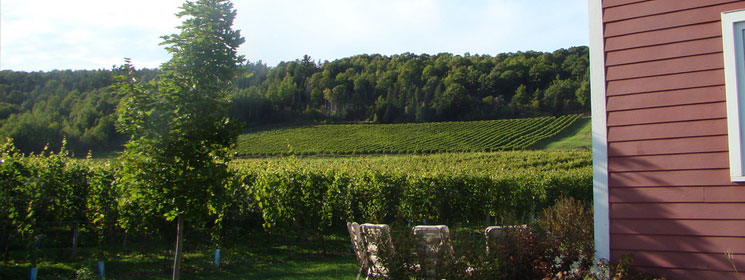Our wine industry here in Nova Scotia is growing in leaps and bounds. It is really helpful for wine lovers to be able to see what’s happening in vineyards throughout the year- it helps us appreciate the work that goes into making great wine.
What is happening in local vineyards this time of year?
Throughout winter vineyard crews have been intensively working to prune the vineyards across Nova Scotia.
Now that the Spring weather has arrived, the temperature is gradually rising and heating the soil, awakening the vine’s roots from dormancy. When the average daily temperatures eventually hit 8-12 C, the vine’s sap starts to flow upwards from the roots. The buds will begin to swell and the vine will start to “bleed” juices from their cuts left after winter pruning. Bud burst in the Northern Hemisphere depends on the daily average temperature exceeding 10C; in some wine regions, this bud burst happens at the end of March and early April. In Nova Scotia, a cold climate viticultural area with cooler Springs, this happens later. To compare Bordeaux and Nova Scotia, which share the same 45 degree Northern latitude; in Bordeaux, bud burst starts in March while in Nova Scotia it normally begins the first few weeks of May.
Viticulturalist Farncisco Diez of Perenia Food and Agriculture Inc. outlines the sequence of bud break for vines in Nova Scotia; “the first grape vines to have bud break will be the early hybrids in the first two weeks of May, followed by other hybrids and early Vitis vinifera (e.g. Chardonnay). The sequence of this process depends on where the vineyards are located, for example, in Cape Breton the grapevines will have a later bud burst compared with the Annapolis Valley. So, in the next few weeks, the waking up of different grapevines across Nova Scotia will slowly start.”
Notes from the field
Pruning in our region can happen anywhere from late winter and into mid-Spring, the timing depends on the varietal. At Luckett Vineyards, pruning commenced in February and most of the hybrids are all pruned by the last week of April. The end of April and beginning of May is when the focus turns to the vitis vinifera vines. The choice to prune the more delicate vinifera later in the season is a precaution in avoiding late season cold snaps.
Once pruning is complete, vineyard workers move on to tying the fruiting canes to the lowest wire to wait for bud break. Depending on the grape variety and, of course, the weather, Jurg Stutz at Domaine de Grand Pre is hopeful that this will happen in the next couple of weeks.
Winemaker Mike Mainguy at Luckett Vineyards noted that the buds “are getting a little fuzzy, and are all starting to bleed sap when pruned, so it won’t be too long now!”
This Spring, as compared to last in the vineyard, is much more challenging as a result of last year’s frost. The decision as to which canes are saved, and which ones are removed is difficult when last year’s bud development and vine growth was so stressed and complicated. A serious frost issue, like the one in June 2018, is a multi-year issue and bud hardiness and general vine health is being monitored closely this year. Jurg at Grand Pre noted that there is a very high mortality rate of primary buds, likely a result of last year’s late frost. Their solution is to keep some extra canes & buds and eliminate the non-fruit-bearing shoots later on.
Pests and Diseases
It is still too early in the season to speak of preventative measures for disease management. Yet, after the winter, grape growers are always on the lookout for problems associated with Crown Gall (a pesky bacterial infection common in Nova Scotia vineyards) and general cold damage.
The first pests of the season are usually the deer, as they like to eat new green shoots and growth and damage trellises. The humane solution for keeping deer out of Luckett Vineyards is a tall fence in the more deer-accessible sections and curious noisy dogs.
Once it gets warmer, fungal disease can be an issue for many local vignerons. With the general movement towards a more sustainable environmentally friendly approach to viticulture, vignerons are choosing to be more preventative than reactive in managing vineyards threats. If spraying is necessary, those who spray will spray only when the weather permits.
Weather
Just like the rest of us, vignerons pray for warm sunny days with just the right amount of rain, enough to bring adequate moisture to the soil and encourage a healthy leaf canopy, but too much creates a hotbed for disease. Everyone is keeping their fingers crossed that there are no more frost issues this season.
Hard Work Pays Off
The local vineyards would not survive and produce if it were not for the incredibly hardworking people who are getting their hands dirty and braving the elements. Many producers now rely on a combination of local and migrant workers to keep their vineyards running.
When my father still had his vineyard in Kingsport, and supplied grapes to some local wineries, the struggle he had in finding reliable and qualified workers was quite real. Today, with the increased awareness and interest in Nova Scotia wines and now the year long program at The Nova Scotia Community College for Cool Climate Wine and Viticulture, there should be many enthusiastic graduates looking to put their skills to use in local vineyards and contributing to the growth of our local viticulture and winemaking industry.
Many of the vineyards here in Nova Scotia are now opening for the season. Have you visited yet?

